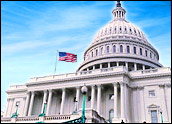
Perhaps nowhere as in government services is the need for truly collaborative software and information systems so great. The organizational and information management challenges are as immense and far-reaching as government itself, and if anything have intensified in the face of budget cuts and constraints, population growth, demographic shifts and a more complex, technologically dependent and affluent society.
Whether they are responding to emergencies, collecting taxes, building and maintaining infrastructure, or administering myriad services, government employees have a pressing need for accurate, timely information — and are charged with delivering services as cost-effectively as possible.
Just as collaborative Web 2.0 software and systems architecture are refashioning customer relationship management (CRM) and enterprise resource planning (ERP) systems by facilitating better communication and information flow, so are they taking hold in government as departments and agencies strive to provide more efficient and effective services.
The Value of Effective Collaboration
The importance of our need for well-informed, well-equipped and coordinated government services was driven home by 9/11 and Hurricane Katrina. Yet responding to terrorist attacks and natural disasters — despite their potential scale and severity — are just two examples in which a host of government offices need to collaborate by making decisions based on data that is often stored in disparate IT systems.
Then comes the task of developing the means to share just the right information between layers of government and among various agencies, as well as others who may be working for any number of private and nonprofit sector service providers.
Though they are similar in many ways to their private sector counterparts, government agencies measure their effectiveness differently.
“Government agencies evaluate their collaboration systems by the agility they render when responding to an event, for example, FEMA responding to hurricanes, or the Treasury responding to the president’s economic stimulus package,” IBM federal region collaboration specialist Thomas Hinders told CRM Buyer.
“Public-facing agencies in particular are judged by their ability to assemble a team in a timely and organized fashion. This includes interagency collaboration and collaboration with third-party organizations to deliver services as needed,” he added.
Also unlike civilian organizations, government agency CIOs are guided not by economic profit and loss but by available budget, Hinders continued. “If they have a small budget, they’re forced to leverage technology to be more effective with the limited resources they have.
“At the end of the day, an effective project or system is one that keeps the government CIO off the front page of the Washington Post, as was the case for FEMA’s response to Hurricane Katrina. These decision makers are passionate about their jobs, and keen to serve the public trust that they have been given. They want a system that is reliable and provides real value to the public when needed.”
Mutually Beneficial Outcomes
For SAP, one of the largest providers of collaborative systems to government, facilitating what it calls “collaborative outcomes” across the public sector comes down to delivering greater value to the public, according to Russ LeFevre, vice president of public services industry solution marketing.
Take the case of an SAP government customer that wanted to deliver constituent services including enforcing and administering to child support payments by non-custodial parents. Doing so entailed designing and building a collaborative information systems environment that cut across at least four distinct types of government agencies: social welfare, legal, law enforcement and financial.
“Typically, the custodial parent files a claim with the state agency that they haven’t received payments. This kicks off a predefined business process,” explained David Kuenzel, CRM solution principal with SAP Public Services. “There are certain integration points that would allow for following through on such a scenario. The state may have to engage local law enforcement to track down the absentee parent, and arrange for certain medical services or information to be obtained to confirm parenthood.”
They may also need or want to cross-reference non-custodial and custodial parent data with the IRS to check for outstanding tax obligations or “with the DMV (Department of Motor Vehicles), as some states will revoke driver’s licenses for nonpayment,” Kuenzel continued, “and they may need to interact with local courts and banks to coordinate account freezes and legal actions … all in order to fashion a closed loop scenario.”
The end result, according to LeFevre, is improved outcomes that fulfill different service lines of business and have higher public value — more specifically, improved operational, social and political benefits. “Political value is enhanced, as elected officials can tout the successful outcomes as examples of government doing more with less, showing transparency and meeting mission goals. Social value is achieved whereby entitled citizens receive necessary financial aid — the custodial mother gets payment. Operational value is achieved when the non-custodial father fulfills his tax obligations, helping the government capture additional revenues.”
A New Generation of Government Employee
Just as is the case in broader society, a new generation of government employees is in the ascendancy in government, and new collaborative information systems are coming with them.
“Contributing to this is the influx of newer, younger employees that are driving agencies towards adopting tools like instant messaging, social software and other systems, such as wikis,” said IBM’s Flinders. “For example, a wiki can be a more effective and less costly way of bringing new hires up to speed, versus bulletin boards, training sessions, e-mails, etc.”
With baby boomers retiring, government agencies “are looking at this as an opportunity to bring in some new perspectives,” added SAP’s LeFevre. “There are more progressive CIO types coming in.”
The reputation of government agencies as being late adopters when it comes to new technology still applies, in large part due to the necessarily conservative nature of government organizations and the numerous legal, regulatory and operational standards and constraints that apply to delivering services. That’s not to say that government agencies aren’t proactively looking to evaluate, adopt and put new collaborative systems to good use, however.
Designed to separate information flow from systems architecture, service-oriented architecture (SOA) is finding a home in a growing number of government agencies. “Two different systems can be put in place but still interact using SOA methodology. Government agencies are among the largest users of SOA in the country,” Flinders commented.
Georgia’s Gwinnett County is a case in point, noted David Arturo, an SAP Public Services account executive. There, the county government in the short space of some 18 months rolled out and “implemented a 311 call center using SAP to collaborate with other aspects of government services, such as road repair, making that part of their overall implementation of a core ERP solution for accounting.”













































